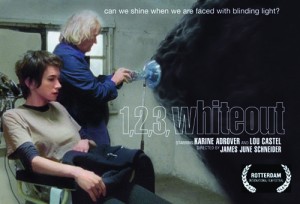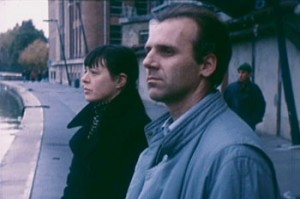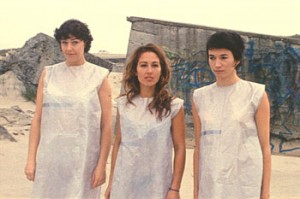1,2,3 whiteout
In a future present, Véronique finds herself employed by an inventor who has dedicated himself to the cause of a “positive” darkness. He is working to counter the tide of a bright, diffuse, and technologically oriented time as represented in the film by manmade light.
Through a series of experiments with the inventor, Véronique learns to re-integrate the blinding light of the present back into relation with its opposite, darkness. Her brother Alix (a government operative) and his team attempt to thwart the process. As the story develops, the film expands from the acted scenes into a lyrical universe composed of archive, filmed, and found sound and image.
DIRECTOR’S STATEMENT
From the outset, my involvement with film and video has developed with the belief that sound and image continue to be a fertile pair, still yielding dynamic forms and functions. The idea for 1, 2, 3, Whiteout (my first feature) came from an image “seed” shot in Kiel, Germany from back in 1999. Since that time, I have collected sounds and images whenever I have traveled in different countries, be it the Gobi desert or New York City. This ongoing relationship and nourishing of that “seed” image enabled a deepening of the central idea of this film through an interaction with the world. This is also perhaps why 1,2,3, Whiteout is nearly half composed of shots without acted scenes.
The script for the film evolved from experiments cutting the shots and sounds one next to another. In addition, the process of collaborating with excellent sound artists, crew, and actors (who were shown the various rushes) all expanded this personal vision in unexpected and dynamic ways. I am indebted to Elise Pierre and to Richard Harrison whose sound experiments fed the process from its inception and also to Lou Castel whose uncompromising and defiant ideas of cinema penetrated the live-action scenes.
James June Schneider
DIRECTOR’S BIOGRAPHY
James June Schneider
Born in Washington D.C. where he began working in music and photography; Schneider played in several bands in his teens in the vibrant DC punk scene. He had his first photo exhibit in a gallery at the age of 18. A few years later, he was drawn to filmmaking while studying at the Rhode Island
School of Design in Providence, Rhode Island, where he made his first film, Alive in the Land of the Ladies (1992), a glam rock science-fiction short.
Schneider has since collaborated with many musicians, doing live projections, music videos, and casting them in various roles such as members of Combustible Edison who play a variant of a Greek chorus in his film Oasis. In 1997, with the group The Make*Up, he made Blue is Beautiful (recently rereleased on DVD on Dischord Records), described by a French critic as “Situationism meets Foucault while taking a ride in the Scooby Doo van”. In addition to collaborations in the realm of music, Schneider worked with the Monadic Institute to create The Staticose Chamber (1996), documenting the audio-visual therapy device under the same name.
The most travelled of his early films are the three shorts which comprise the Dystopian Trilogy : Faerie-Monition, Oasis, and Median Strip. They are condensed surreal impressions of three distinct sites; the prison industrial complex, a corporate planned community, and Euro-Disney. To date, Schneider describes his films as “experiments, mobile pieces of a developing whole.” His films have screened in festivals worldwide and he has toured and discussed his work in screening spaces ranging from museums, to classrooms, to shacks in the countryside across Europe and the USA. In 1997 he organized an 19 city US tour (accompanied by super-8 alchemist Martha Colburn). His films have often been used in film classes as well as by advocacy groups such as Critical Resistance, a prison reform group who used Median Strip as part of their campaign.
Schneider has also served on festival juries and programmed screenings in the U.S. and abroad (La Cinémathèque française, the Corcoran Gallery of Art in Washington, DC amongst others). He has also written for periodicals and museums including the National Gallery of Art (Washington, DC) as well as working for several years as an independent documentary researcher at the National Archives (US) and The Library of Congress.
A year after moving to France in 1998, and parallel to his filmmaking, Schneider pursued his graduate studies, earning a Masters and DEA degrees in philosophy. In 2001 he began vampling (video-audio sampling) at first with the group AE (Sonig records) and then solo under the name Matterlink (www.vampler.net/matterlink). Other ongoing work includes a documentary project with filmmaker Paul Bishow (The Bad Brains Movie) on punk/hardcore music from Washington DC.



